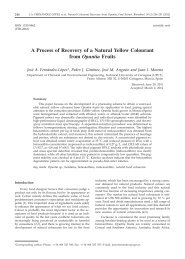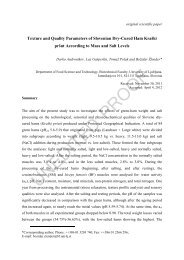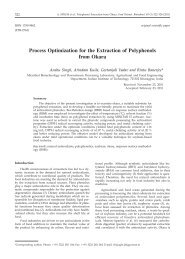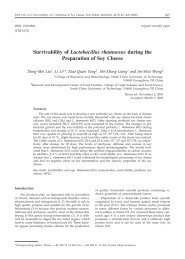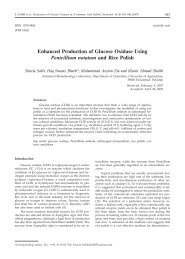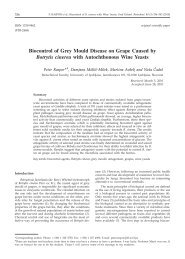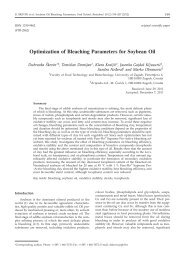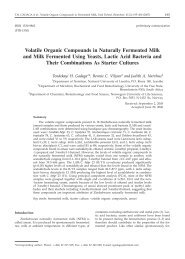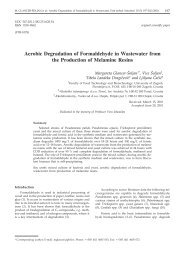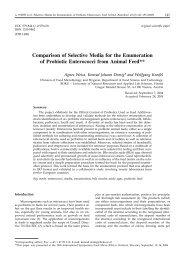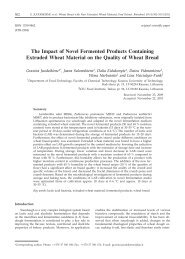Effect of Casein Hydrolysates on Yogurt Fermentation - Food ...
Effect of Casein Hydrolysates on Yogurt Fermentation - Food ...
Effect of Casein Hydrolysates on Yogurt Fermentation - Food ...
You also want an ePaper? Increase the reach of your titles
YUMPU automatically turns print PDFs into web optimized ePapers that Google loves.
432 Q.Z. ZHAO et al.: <str<strong>on</strong>g>Effect</str<strong>on</strong>g> <str<strong>on</strong>g>of</str<strong>on</strong>g> <str<strong>on</strong>g>Casein</str<strong>on</strong>g> <str<strong>on</strong>g>Hydrolysates</str<strong>on</strong>g> <strong>on</strong> <strong>Yogurt</strong> Fermentati<strong>on</strong>, <strong>Food</strong> Technol. Biotechnol. 44 (3) 429–434 (2006)Coagulati<strong>on</strong> time/h4.54.03.53.02.52.01.51.00.50CH1 CH2 CH3<str<strong>on</strong>g>Casein</str<strong>on</strong>g> hydrolysatesFig. 2. Coagulati<strong>on</strong> time <str<strong>on</strong>g>of</str<strong>on</strong>g> yogurt with added casein hydrolysates.CH1, CH2, CH3 and the columns represent the same as inFig. 1Probiotic counts/(log CFU/mL)9.08.58.07.57.06.56.0pH4.454.404.354.304.254.204.154.104.054.003.95CH1CH2<str<strong>on</strong>g>Hydrolysates</str<strong>on</strong>g>CH3Fig. 3. Change in pH <str<strong>on</strong>g>of</str<strong>on</strong>g> yogurts with added hydrolysates afterstorage for 30 days. CH1, CH2, CH3 and the columns representthe same as in Fig. 1riod <str<strong>on</strong>g>of</str<strong>on</strong>g> 30 days at low temperature. Post-fermentati<strong>on</strong>acidificati<strong>on</strong> had a negative effect <strong>on</strong> the quality, andshortened the shelf life. It is closely associated with thepersistent metabolic activity <str<strong>on</strong>g>of</str<strong>on</strong>g> lactobacilli during coolingat4°C(24).Decrease in post-fermentati<strong>on</strong> acidificati<strong>on</strong>was favourable for sensory improvement and c<strong>on</strong>sumers’preference.5.50 1 2 3 4 5Fermentati<strong>on</strong> time/hFig. 4. <str<strong>on</strong>g>Effect</str<strong>on</strong>g> <str<strong>on</strong>g>of</str<strong>on</strong>g> the supplement <str<strong>on</strong>g>of</str<strong>on</strong>g> hydrolysates <strong>on</strong> growth <str<strong>on</strong>g>of</str<strong>on</strong>g> probioticbacteria in yogurt. CK, CH1 (0.5 %), CH1 (1.5 %), CH2 (0.5 %), ´ CH2 (1.5 %), + CH3 (0.5 %), CH3 (1.5 %). CH1,CH2 and CH3 are the same as in Fig. 1Change in growth and viability <str<strong>on</strong>g>of</str<strong>on</strong>g> probiotic bacteriaduring fermentati<strong>on</strong> and storageThe growth <str<strong>on</strong>g>of</str<strong>on</strong>g> probiotic organisms during fermentati<strong>on</strong>is presented in Fig. 4. The hydrolysates increasedthe probiotic counts at initial stage compared to the c<strong>on</strong>trol.It indicated that the hydrolysates enhanced thegrowth <str<strong>on</strong>g>of</str<strong>on</strong>g> probiotic organisms. However, the growth <str<strong>on</strong>g>of</str<strong>on</strong>g>the probiotic organisms decreased at the final stage whenthe hydrolysates were added. The growth <str<strong>on</strong>g>of</str<strong>on</strong>g> these bacteriadecreased with the increase in the additi<strong>on</strong> <str<strong>on</strong>g>of</str<strong>on</strong>g> hydrolysates.This was related to the decrease in fermentati<strong>on</strong>time.L. acidophilus and B. bifidum have to retain viabilityand activity in the food system to meet the requirementsfor c<strong>on</strong>sumpti<strong>on</strong> (25). Viability <str<strong>on</strong>g>of</str<strong>on</strong>g> probiotic bacteria inproducts during l<strong>on</strong>g shelf life at refrigerati<strong>on</strong> temperatureis generally unsatisfactory (8,26) because the lowsurvival <str<strong>on</strong>g>of</str<strong>on</strong>g> probiotic organisms in the fermented dairyproducts is the greatest obstacle encountered in processing,and especially during storage (27).The counts <str<strong>on</strong>g>of</str<strong>on</strong>g> probiotic bacteria in yogurts decreasethroughout storage. However, decline in the counts <str<strong>on</strong>g>of</str<strong>on</strong>g>probiotic organisms during storage can be retarded byhydrolysates (Fig. 5). After 30 days <str<strong>on</strong>g>of</str<strong>on</strong>g> storage, the yogurtswith the hydrolysates have more probiotic bacteriathan the c<strong>on</strong>trol. The yogurt with 1.5 % <str<strong>on</strong>g>of</str<strong>on</strong>g> CH3 hasabout 3-fold more probiotic bacteria than the c<strong>on</strong>trol.The hydrolysates significantly (p



